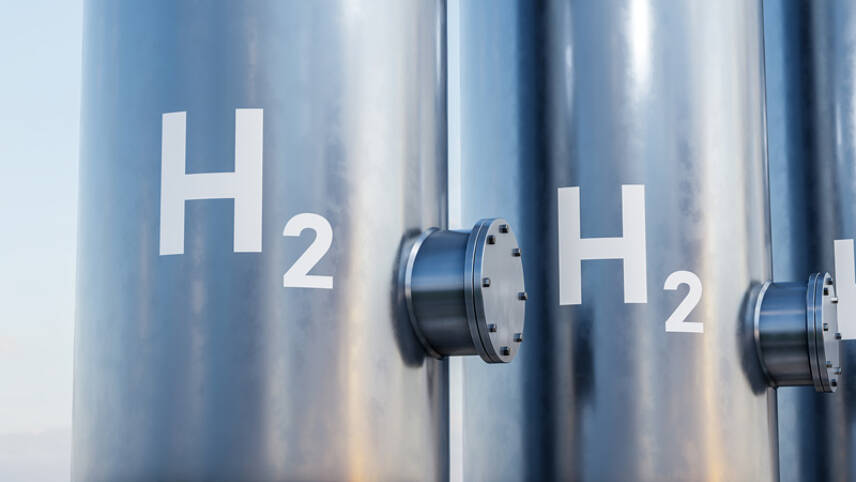Register for free and continue reading
Join our growing army of changemakers and get unlimited access to our premium content

Announced in September 2022 by Commission President Ursula von der Leyen, the EU’s Hydrogen Bank is seen as a vital part of the bloc’s goal of producing 10 million tonnes of renewable hydrogen by 2030, on top of the additional 10 million tonnes expected from imports.
But Brussels is also eyeing the business opportunities hydrogen offers.
“Hydrogen is an industry where the EU is still well ahead of global competition,” explained the EU’s Green Deal Chief, Frans Timmermans, late last week “Over 50% of installed electrolyser capacity and over 50% of electrolyser manufacturing capacity is here in the EU,” he pointed out.
Hydrogen, when produced using renewable electricity, is largely climate neutral. If affordable enough, demand for “green” hydrogen is nearly guaranteed in sector like petrochemicals, which currently use dirty hydrogen produced from fossil gas.
“It is clearly a key technology,” Timmermans stressed. But, “only 10% of hydrogen projects have reached the final investment decision.”
This is where the EU’s hydrogen bank comes in. The new facility is aimed at solving the chicken-and-egg problem whereby potential producers of hydrogen are not assured of finding buyers for their product.
“For renewable Hydrogen produced in the EU, the bank will cover the green premium,” Timmermans explained.
Starting in autumn 2023, the bank will call for bids. Companies that want a slice of the €800m available must submit their production offers and those with the lowest costs will be awarded the money. The funding comes from the Innovation Fund, which draws its revenues from the EU’s carbon market.
Going forward, Timmermans wants to offer the auction platform to EU governments for their own use. This scheme will be called “auctions as a service.”
In the coming years, the bank will also help facilitate the import of foreign-produced hydrogen. Little is known about this second pillar of the bank at this stage, with Timmermans only saying that the European Commission “will decide later on how to support this”.
According to EU officials, the main issue to be solved is the funding source for projects outside Europe. The support mechanism covering the green premium is expected to be the same for intra-EU projects.
Officials have estimated that, the green premium to achieve the 2030 targets for hydrogen will come up to about €100bn in total, including both domestic projects and those developed abroad. Since the hydrogen bank has a budget of €3bn, the EU’s executive is therefore reliant on the private sector to fill the gap.
Industry cheer
The hydrogen industry welcomed the European Commission’s push.
“Today is a turning point for accelerating the European hydrogen economy,” commented Jorgo Chatzimarkakis, the chief executive of industry lobby group Hydrogen Europe.
According to Chatzimarkakis, the hydrogen bank is the “cherry on top” alongside other recent EU initiatives that bolstered hydrogen’s place in the EU’s industrial policy landscape.
To Hydrogen Europe, the bank is the “first pillar” of the EU’s hydrogen economy. The Renewable Hydrogen Coalition, another industry group backed by renewable energy companies, also applauded the Commission’s push. “Delivering the volumes we need will only happen with strong value chains,” said Francois Paquet, impact director at the coalition.
Remaining questions
However, some industry experts have expressed doubt about the size of the hydrogen bank, given the EU’s 2030 production goals.
“More like a drop in a leaky bucket,” tweeted Andreas Graf, senior associate in charge of EU energy policy at the German think-tank Agora Energiewende.
“At €1 in support per kg of hydrogen, you would need €1bn to finance the support costs of one million tonnes of hydrogen,” he pointed out, saying production costs of green hydrogencurrently range between €2.5 to €15 per kilo.
As a consequence, much more financing would be required, he said.
“The European Hydrogen Bank is a win for the lobbyists,” said Gniewomir Flis, a hydrogen analyst.
Once the EU has subsidised the production of a kilogram of hydrogen, anyone can purchase it. “Funds could be more efficiently allocated to a Net Zero Industry bank which would have auctioned off carbon contracts for difference,” he said on Twitter.
Bellona, the Norwegian think-tank, voiced a similar sentiment. “This scheme misses a key opportunity to channel hydrogen to those sectors that would need it the most and have no alternative decarbonisation pathway,” said Marta Lovisolo, policy advisor.
Nikolaus J Kurmayer, EurActiv.com
This article first appeared on EurActiv.com, an edie content partner


Please login or Register to leave a comment.